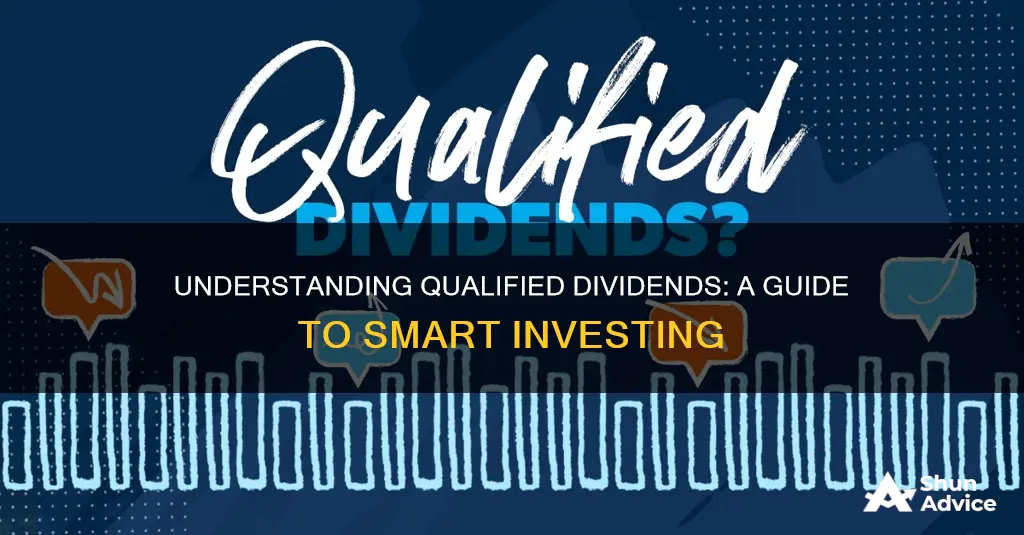
Qualified dividends are a type of investment income that receives preferential tax treatment from the IRS. Compared to ordinary dividends, qualified dividends are taxed at a lower rate. To be considered a qualified dividend, the payout must be made by a U.S. company or a foreign company that trades in the U.S. or has a tax treaty with the U.S. Investors must also meet specific holding period requirements, typically holding the shares for more than 60 days during a 121-day period before the ex-dividend date. Qualified dividends are generally taxed at the capital gains tax rate, which can be up to 15%, resulting in significant tax savings for investors.
| Characteristics | Values |
|---|---|
| Tax rate | 0%, 15% or 20% depending on income level |
| Type of dividend | Regular dividend |
| Type of company | U.S. corporation or qualified foreign corporation |
| Holding period | More than 60 days during a 121-day period beginning 60 days before the ex-dividend date |
| Type of security | Unhedged shares with no puts, calls, or short sales |
What You'll Learn

Qualified vs. Ordinary Dividends
Dividends are a portion of a company's earnings that are distributed to shareholders. They are usually paid out on a regular basis, such as quarterly, monthly, or annually, and can be in the form of cash or additional shares of stock. Dividends can be classified as either ordinary or qualified.
Ordinary dividends are taxed as ordinary income, which means they are subject to the recipient's regular income tax rate. For some, this can mean a rate as high as 37% for federal income tax if they fall into the highest tax bracket.
On the other hand, qualified dividends are taxed at a lower rate, generally the long-term capital gains tax rate. The concept of qualified dividends was introduced with the 2003 tax cuts signed into law by George W. Bush. The lower qualified rate aimed to address an unintended consequence of the U.S. tax code, which was incentivizing companies not to pay dividends. The maximum tax rate for qualified dividends is 20%, with a few exceptions for real estate, art, or small business stock.
The tax rate on qualified dividends for the 2024 tax year is 15% for most taxpayers. It's 0% for single taxpayers with incomes below $47,025, and 20% for single taxpayers with incomes over $518,901. In contrast, ordinary dividends are taxed at the taxpayer's normal marginal tax rate.
To be considered a qualified dividend, the payout must be made by a U.S. company or a foreign company that trades in the U.S. or has a tax treaty with the country. Additionally, to qualify, the shareholder must hold the shares for more than 60 days during the 121-day period that starts 60 days before the ex-dividend date.
The IRS has set specific criteria that must be met for a dividend to be considered qualified. These criteria include the dividend being received from domestic or qualified foreign corporations, the stock being held for the required holding period, and the investment not being a real estate investment trust (REIT), master limited partnership (MLP), employee stock option, tax-exempt company, or listed with the IRS as an unqualified investment.
Understanding the difference between qualified and ordinary dividends is essential for investors, as it can help lower their tax bill and plan their investments more effectively.
Young Investors: Why the Reluctance?
You may want to see also

Tax Implications
Ordinary dividends are taxed at the investor's marginal tax rate, which can be as high as 37%. However, qualified dividends are taxed at the long-term capital gains rate, which is generally no higher than 15%. For the 2024 tax year, the tax rate on qualified dividends is 0% for single taxpayers with incomes under $47,025, 15% for most other taxpayers, and 20% for single taxpayers with incomes over $518,901.
The tax rate on qualified dividends also depends on the investor's income level. For example, if an investor's income is less than $40,400 in 2021 ($80,800 for those married and filing jointly), they wouldn't have to pay any taxes on qualified dividend income. However, they would have to pay a 10% to 12% tax on non-qualified dividends.
Additionally, high-income taxpayers may be subject to the Net Investment Income Tax (NIIT), which is an additional 3.8% tax on investment income, including qualified dividends, for individuals with an adjusted gross income above certain thresholds. These thresholds are:
- $200,000 for single filers
- $250,000 for married filing jointly
- $125,000 for married filing separately
To be considered a qualified dividend, the payout must be made by a U.S. company or a qualified foreign company. A foreign company qualifies if it is incorporated in a U.S. possession, is located in a nation covered by an income tax treaty with the U.S., or its stock is readily tradable in the U.S. securities market.
Another requirement for a dividend to be considered qualified is the holding period. For most dividends from stocks and funds, the investor must have held the shares for 61 days out of a 121-day period that began 60 days before the security's ex-dividend date. The ex-dividend date is the date after the dividend has been paid and processed, and any new buyers would be eligible for future dividends.
Dividends that do not meet the requirements for qualified dividends include those from real estate investment trusts (REITs), master limited partnerships (MLPs), non-qualified employee stock options, tax-exempt companies, and money market accounts.
What Your Neighbors Are Investing In
You may want to see also

Requirements for Qualification
To qualify for the lower tax rate, dividends must meet the following requirements:
Paid by a U.S. or qualified foreign corporation
The company must be either a U.S. corporation or a foreign corporation that trades in the U.S. or has a tax treaty with the U.S. A foreign corporation is considered qualified by the IRS if it is incorporated in a U.S. possession or is eligible for benefits under a comprehensive income tax treaty with the U.S. If a foreign corporation does not meet either of these criteria but is traded on a U.S. securities exchange, it is treated as a qualified foreign corporation.
Holding period requirements
For most dividends from stocks and funds, the shareholder must have held the shares for 61 days out of a 121-day period that began 60 days before the security's ex-dividend date. The ex-dividend date is the date after the dividend has been paid and processed, where any new buyers would be eligible for future dividends. The record date, the day before the ex-dividend date, is when a shareholder must be on the company's books to receive the dividend. For certain preferred stock dividends to be treated as qualified dividends, the security must be held for 91 days out of the 181-day period, beginning 90 days before the ex-dividend date.
Unhedged shares
The shares must be unhedged, meaning there were no puts, calls, short sales, or other hedging strategies associated with the shares during the holding period.
REITs: Invest Now or Later?
You may want to see also

Holding Periods
Common Stock Holding Periods:
For common stock, shareholders must hold their shares for more than 60 days within a specific 121-day period. This 121-day period starts 60 days before the ex-dividend date. The ex-dividend date is the day before the dividend's record date, which is when a shareholder must be on the company's books to receive the dividend. In other words, investors need to purchase the stock before the ex-dividend date and hold it for at least 61 days during this 121-day window to qualify for the preferential tax treatment.
Preferred Stock Holding Periods:
Preferred stocks have different holding period requirements compared to common stocks. Investors must hold preferred stocks for more than 90 days during a 181-day period that starts 90 days before the ex-dividend date. This longer holding period for preferred stocks is an important distinction to consider when planning your investment strategy.
Mutual Fund Holding Periods:
The holding period requirements for mutual funds also differ slightly. The mutual fund itself must have held the security unhedged for at least 60 days out of the 121-day period that begins 60 days before the security's ex-dividend date. Additionally, investors must have held the applicable share of the mutual fund for the same period to receive capital gains tax treatment.
Understanding the Impact of Holding Periods:
Meeting the minimum holding period is a critical requirement for dividends to be designated as qualified. If you fail to meet the holding period requirements, the dividends will be treated as ordinary income and taxed at a higher rate. By planning your investments with the holding periods in mind, you can maximise the tax benefits associated with qualified dividends.
Hedging Restrictions:
It's important to note that qualified dividends cannot be associated with hedging strategies. This means that shares involved in short sales, calls, puts, or other hedging techniques during the holding period will not qualify for the preferential tax rate.
BlackRock: Investors' Choice
You may want to see also

Non-Qualified Dividends
- Dividends paid by certain foreign companies. A foreign company's dividends may be disqualified if it isn't part of a comprehensive income tax treaty with the US or if its stock isn't readily tradable on an established US securities market (e.g. Nasdaq or NYSE).
- Distributions from certain US entities, such as real estate investment trusts (REITs) and master limited partnerships (MLPs).
- Dividends paid on employee stock options.
- Special one-time dividends.
- Dividends that don't meet the IRS's minimum holding period to qualify for a lower tax rate. Common stock investors must hold shares for more than 60 days during a 121-day period that starts 60 days before the ex-dividend date.
- Dividends paid on bank deposits, such as credit unions or savings and loans.
- Dividends from tax-exempt corporations or farmers' cooperatives.
- Dividends paid to an ESOP (Employee Stock Ownership Plan).
- Dividends on stocks where you hold a short derivative position.
- Payments in lieu of dividends.
- Non-dividend distributions, or payments that are not from earnings and profits.
- Liquidating dividends.
At the end of the year, you will receive an IRS Form 1099-DIV from the company or your custodian. Ordinary dividends are shown in Box 1a, while qualified dividends are in Box 1b.
Energy Investment: Now or Never?
You may want to see also
Frequently asked questions
A qualified dividend is a type of investment income that receives preferential tax treatment from the IRS. It is an ordinary dividend that meets the criteria to be taxed at capital gains tax rates, which are lower than income tax rates for some taxpayers.
For a dividend to be considered qualified, it must meet certain requirements, including:
- Paid by a U.S. corporation or a qualified foreign corporation.
- A regular dividend, not a capital gains distribution or dividend from a tax-exempt organization.
- The investor held the underlying stock for more than 60 days during a 121-day period beginning 60 days before the ex-dividend date.
- The shares must be unhedged, with no puts, calls, or short sales associated with them during the holding period.
Qualified dividends are generally taxed at the capital gains tax rate, which is typically no higher than 15%. However, the taxable income of the individual determines the exact rate. For high-income taxpayers, the net investment income tax (NIIT) may also apply, resulting in an additional 3.8% tax on qualified dividends.
Examples of companies that pay qualified dividends include Apple (AAPL) and Enbridge (ENB). As a U.S. corporation, Apple's regular dividend payments qualify for a lower tax rate. Enbridge, a Canadian corporation trading on the New York Stock Exchange, also qualifies for a lower tax rate for U.S. citizens as long as they meet the holding period requirement.
The biggest advantage of qualified dividends is the potential tax savings for investors. Depending on the income level, the tax rate on qualified dividends can be significantly lower than that of nonqualified or ordinary dividends. This results in more money remaining in the investor's pocket.







